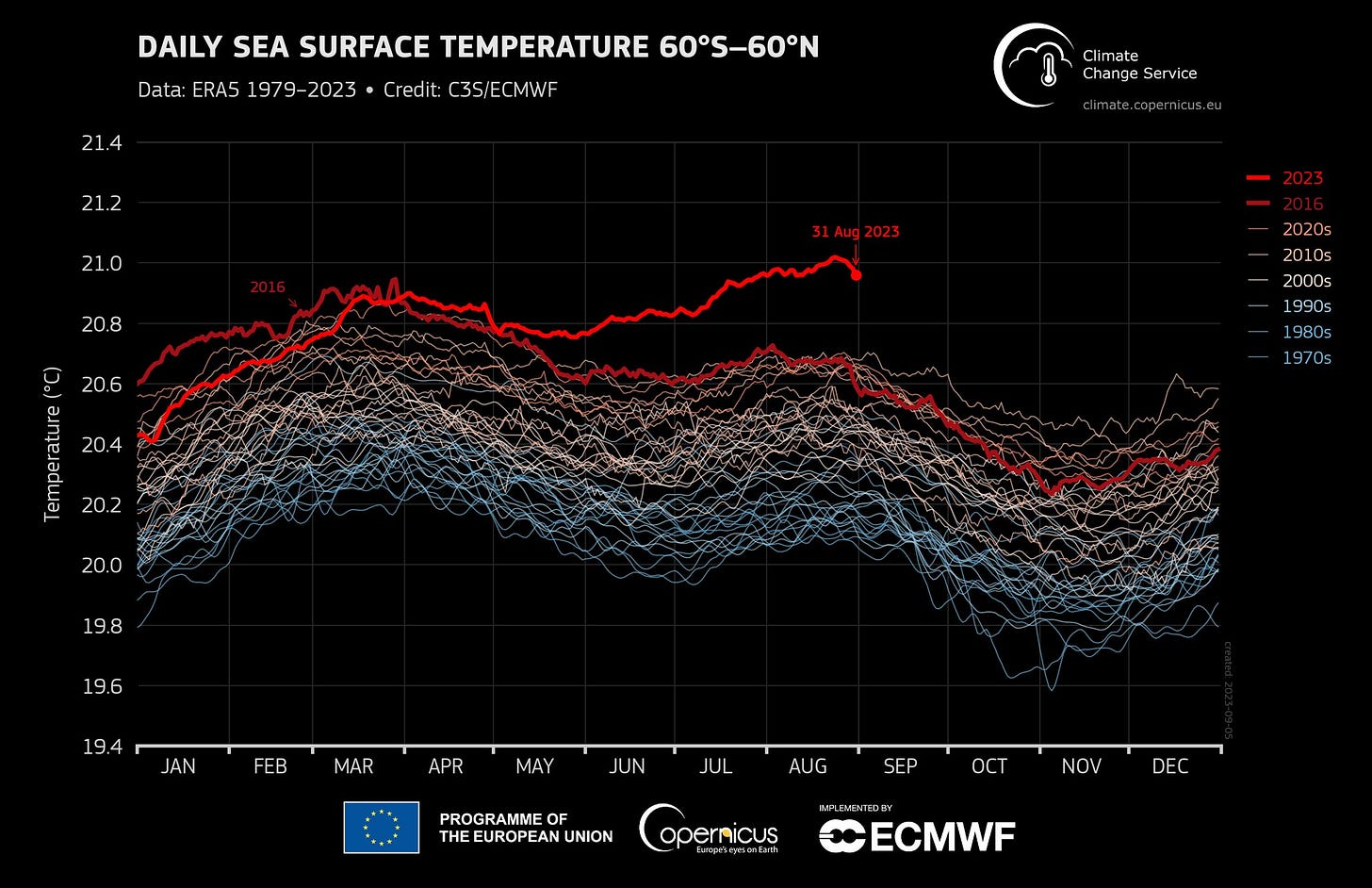Termination Shock
How shipping regulations for cleaner air explain the sudden rise in ocean temperatures.
"We live in a world, where deliberately dimming the fucking sun might be less risky than not doing it.” – Elizabeth Colbert
Imagine you could cool the planet from one year to the next. Imagine you could avert many of the disasters that come with a rapidly warming planet. Imagine you could deflect heat coming from the sun. This is what Harvard scientist David Keith is working on. He researches solar radiation management (SRM), the idea of “dimming the fucking sun” by injecting sunlight-reflecting aerosols into the stratosphere. The idea is inspired by the cooling effect of volcanic eruptions like Pinatubo in 1991, which lowered global mean temperatures by 0,6 degrees Celsius for 15 months.
There are many, many problems and enormous risks that come with SRM. Sulphate aerosols, the most researched option, are pollutants for one. Another is termination shock. What if for some reason SRM stops from one day to the next? It would likely mean that instead of linear warming, you have a sudden jolt with ecosystems and our food production systems having a difficult time adjusting.
When Keith and his colleagues proposed a very early stage experiment in Sweden that would just have tested an apparatus to later inject minuscule amounts of aerosols into the stratosphere, opposition was swift. Indigenous leaders, activist Greta Thunberg and climate scientist Michael Mann came together to publicly denounce the experiment. Faced by the backlash, Swedish authorities canceled the experiment. But despite all the controversy, it seems, we have accidentally done SRM for years. And the sudden warming we see now (especially over the Oceans of the Northern Hemisphere) is described by some as termination shock.
Let’s go bak to the basics for a second. The best scientific explanation for the warming we have seen over the past decades is that it is human made. “The bottom line is that multiple studies indicate with very strong confidence that human activity is the dominant component in the warming of the last 50 to 60 years, and that our best estimates are that pretty much all of the rise is anthropogenic,” writes Gavin Schmidt, Director of the NASA Goddard Institute for Space Studies and one of the most cited climatologist.
Analysing the IPCC’s attribution, Schmidt points out that the best implied guess is that human activity did not merely contribute 100 percent to the warming we have seen, but 110 percent with the most extreme estimate going up to 130 percent. How can that be? Our activities not only warm the planet, some also cool it, masking some of the warming we should see based on the increase in greenhouse gases. The Catch 22 is that we cool the atmosphere by polluting it. And by fighting the pollution, it seems we have inadvertently triggered rapid warming.
In 2020, the International Maritime Organization put new regulations in place to lower shipping pollution. They required an 86 percent reduction in sulfur content of shipping fuels. There are around 60,000 cargo ships in the world and they are some of the biggest machines we have ever built. The effect was observable right away and most pronounced in the Northern Hemisphere. Clouds that were induced by aerosols from shipping emissions went to down significantly according to NASA.
In November of 2021, Leon Simons, James E. Hansen and Yann Dufournet published a paper warning of termination shock due to a reduction in sulphate aerosols. As the main cause they identified cleaner shipping fuels, which had already started selling in October 2019. Simons reactivated his dormant Twitter account 3.5 years ago. “To create awareness about rapid warming from rapidly reducing air pollution”, as he wrote in a Tweet.
Does cleaner air explain all of the sudden warming? Maybe. Michael Mann points out that there is less than usual Saharan dust, which could also have a warming effect. Also, the eruption of the Hunga Tonga–Hunga Haʻapai last year added to the warming we are seeing now, because it injected enormous amounts of water in the atmosphere increasing water vapour by a staggering five percent, which, other than aerosols, has a warming effect.* But maybe it is simply our greenhouse gas emissions. “Climate change and El Niño [which is still building up] can explain it all,” Imperial College of London climate scientist Friederike Otto said to Euronews.
*There is much speculation going around concerning Hunga Tonga–Hunga Haʻapai, but no scientific consensus about its concrete effects. Maybe it added to the warming, maybe it added to the extreme rainfall we have seen in recent weeks. I would not rule it out, but the effect of our emissions is surely stronger than the effects of Hunga Tonga.



Lets be clear Daniel, SRM is climate suicide. And this shipping fuel effect is highly speculative and likely used for framing SRM. Where is the map where shipping routes are overlapping with overly warming of ocean water? Why does warming not show in the Arab Sea, or the Gulf of Bengal, some of the world's busiest routes? Please, don't add to the confusion, its too complex to make it sound so simple.....